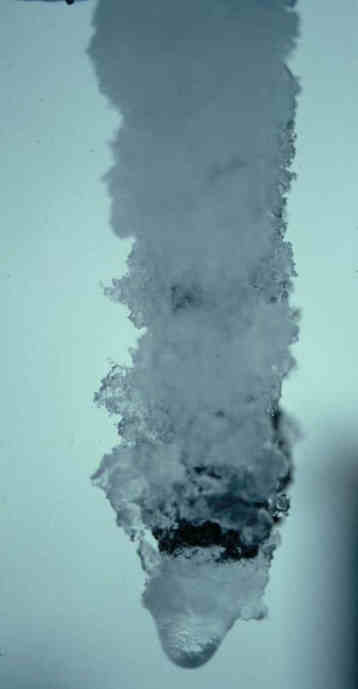BACKGROUND:
Students have learned that a substance is more likely
to go into solution in a solvent at a higher temperature than at a lower
temperature. If a solution is allowed to cool, the solute will precipitate
from the solution as a solid. Slower cooling solutions grow larger and more
perfect crystals. Cooling is only one of many ways to grow crystals, whether
they are organic or inorganic.
A crystal is a collection of atoms or molecules
structured in a specific repeatable pattern. The patterns can be simple or
complicated. A new crystal grows most easily by attaching itself to a
surface of a preceding crystal. The new, growing crystal does not usually
attach exactly enough to duplicate the existing crystal. The new crystal
thus grows as what is termed a "dislocation." This is one reason
why clusters of small crystals are common, but large perfect crystals are
rare. Many other environmental factors determine how perfect a crystal will
be.
PROCEDURE:
- In this activity the students grow, observe, and compare salt and
sugar crystals. The actual growth of the crystals may take several days,
depending on the temperature of the solutions. You may want to make
several solutions and put then in different areas of the classroom.
-
To
make Salt Crystals. Boil water and dissolve as much salt in the solution
as possible. The solution will be supersaturated when salt crystals
begin to collect on the bottom of the pan.
We recommend two methods for precipitating salt crystals:
- Soak a piece of cardboard in the solution until it is saturated
and sinks to the bottom of the pan. The cardboard will act as a base
for crystal growth. Put the pan in a sunny location. Crystals will
form as the water evaporates. This may take several days.

- Simply place the pan of solution in a warm location, and allow
crystals to grow without a template.
Both methods work. You may wish to try several pans, and study
how the growth of crystals varies between them.
- To make Sugar Crystals. Boil about 400 ml water. Add about 200 ml of
sugar to the water, and stir the solution well. Pour the solution into
the jar. Make sure that the jar you selected can withstand the
temperature (beaker should work). Tie a paper weight to the end of the
string to keep it straight. Suspend the string from a pencil. Submerge
the string in the solution. The sugar crystals will grow slowly on the
string over a period of several days.
- Instruct the students to observe the crystals daily, and record how
they change. Have them record their observations in a log, so they can
then compare the results as a class. The following page shows a sample
log, with space for observation and illustration. If more than two
solutions are used, the log will need to be duplicated.
- After a week you can discuss which solution made the best crystals and
try to determine why one is better than the other. Generally, the slower
a crystal forms, the larger it will be.
|